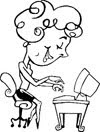I have been asked by a few people how I shade my projects to give them a three dimensional look. I figured I would write a quick, basic, hopefully user friendly tutorial on how to do it.
The diagrams below show a light source coming from the upper right hand corner and the effects it has on a shape. You have the highlight on the upper right, where the light source is coming from. You have the darkest area on the lower left, where there is the least amount of light. When you are shading your paper you have to think about these basic principles.

To show this in a more practical shading sense, like how you would shade a card, here is an example that I made.
This is a brocade blue large oval from the center of the scallop oval frame die and the Big shot.

First you need the same color ink as your paper, or a gray or Sahara Sand for a light color or white paper. Also you will need a sponge. I cut the large sponges into quarters and that seems to be a very good size.
CLICK HERE to see how I store my sponges to make it easy.

I am pretending that my light source is coming from the upper left corner and that this oval shape is really a rounded egg.
Using the sponge and a light circular motion I darkened the bottom right hand side of my shape. Do a little first, take a minute to look at it and do some more if you want it more defined.


Then I take a marker in the same color and darken the bottom right hand side. I make it wider at the farthest corner from the light source and do another layer on that bottom right section to make it even darker.

Then last I add my highlight with my white gel pen in the corner that the light source is hitting. You are done! You now have a rounded egg looking shape out of a totally flat piece of paper! Now you can just apply this same technique to whatever shape you have using the shading chart above.

I hope this was helpful! I tried to keep it pretty basic.
Here are some good links I found for more information on this topic:
1. CLICK HERE
2. CLICK HERE
3. CLICK HERE
4. CLICK HERE




 ABC Book
ABC Book 3 Card w/ Box
3 Card w/ Box Jar Gift Set
Jar Gift Set Pocket Glider Card
Pocket Glider Card Tri-fold Wedding
Tri-fold Wedding Sunhat & Glasses
Sunhat & Glasses Flirtatious Purse
Flirtatious Purse Swap Garden Bag
Swap Garden Bag Star Cards/Box
Star Cards/Box Fun Frames
Fun Frames Treasure Box, Card
Treasure Box, Card Fun Folds Open Sea
Fun Folds Open Sea Glider Card
Glider Card Nurse Box & Cards
Nurse Box & Cards Race Car Box
Race Car Box Castle Frame
Castle Frame Egg Gift Card
Egg Gift Card Bug Cards
Bug Cards Tux card
Tux card Flip Calendar
Flip Calendar Photo CD Album
Photo CD Album Gingerbread Box
Gingerbread Box Gift Card Holder
Gift Card Holder Fold Scrapbook
Fold Scrapbook Diabetes Purse
Diabetes Purse X-mas Cards
X-mas Cards Haunted House
Haunted House Chef Pop-out
Chef Pop-out Chef Pop-out
Chef Pop-out Owl Cards 2
Owl Cards 2 Spooky Punches
Spooky Punches Foliage Box+Cards
Foliage Box+Cards Owl Purse +Cards
Owl Purse +Cards Bus, Fire, Police
Bus, Fire, Police Briefcase & Cards
Briefcase & Cards Cylinder Purse
Cylinder Purse AE 3 Cards
AE 3 Cards Pie Box&Card
Pie Box&Card Potato Heads
Potato Heads Castle Album
Castle Album Scrapbook Album
Scrapbook Album Scrapbook Album
Scrapbook Album Purse & Wallet
Purse & Wallet Jar Cards
Jar Cards Animal Cards
Animal Cards Barn & Cards
Barn & Cards Gardeners Bag
Gardeners Bag Picnic Basket
Picnic Basket Cupcake cup
Cupcake cup Chocolate Candy
Chocolate Candy Bird in Cage
Bird in Cage Pool Table
Pool Table Wheelbarrow
Wheelbarrow Bird Cards#2
Bird Cards#2 Bird Cards
Bird Cards Jewelry Box
Jewelry Box Clock Game
Clock Game Purse & Cards
Purse & Cards Rag Purse
Rag Purse Teapot and Cards
Teapot and Cards Sheep box & cards
Sheep box & cards Egg Box & Chicks
Egg Box & Chicks Doctor's Bag
Doctor's Bag Pop-out Flower
Pop-out Flower Suit Dress Card
Suit Dress Card Explosion Box
Explosion Box Vest Card
Vest Card Tackle Box
Tackle Box Noah's Ark
Noah's Ark Love Coupon
Love Coupon Pull-out Scrapbook
Pull-out Scrapbook Calendar Book
Calendar Book Card Box
Card Box Cupcake Box
Cupcake Box Photo Box
Photo Box Woven Basket
Woven Basket Six Pack Baby Jars
Six Pack Baby Jars Scrapbook
Scrapbook Scrapbook
Scrapbook Santa Wine
Santa Wine Top Note Album
Top Note Album Top Note Album
Top Note Album Decorative Candles
Decorative Candles Origami Cube-Box
Origami Cube-Box Origami Album
Origami Album



















